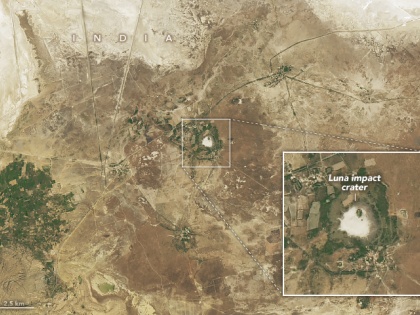Luna Crater in Gujarat Confirmed as Meteorite Impact Site by NASA Studies
By Lokmat English Desk | Updated: April 25, 2024 17:24 IST2024-04-25T17:23:05+5:302024-04-25T17:24:08+5:30
NASA's Earth Observatory satellite has recently photographed Luna, a crater measuring 1.8km in width located in India's Gujarat state ...

Luna Crater in Gujarat Confirmed as Meteorite Impact Site by NASA Studies
NASA's Earth Observatory satellite has recently photographed Luna, a crater measuring 1.8km in width located in India's Gujarat state within the Banni Plains. Named after the nearby village, Luna has become the subject of scientific intrigue as recent studies suggest it may have formed from a meteorite impact thousands of years ago. Initially suspected by researchers, this colossal crater's origins point towards a dramatic collision between Earth and a space rock, adding to the mysteries of our planet's history.
A 2024 research paper focusing on the Luna crater reveals that chemical analysis has unveiled distinct signatures consistent with a meteorite impact. This finding adds weight to the hypothesis of Luna's celestial origins. The striking image of the Luna crater from space was obtained by the Operational Land Imager instrument aboard the Landsat 8 satellite on February 24, 2024, as part of NASA's Earth Observatory program, providing valuable insights into the geological features of this intriguing site.
Analyzing the Luna crater reveals dimensions of approximately 1.8 kilometers (1.1 miles) across, with its outer rim towering about 6 meters (20 feet) above the crater floor. Situated within a typically submerged low-lying area, Luna frequently holds water within its confines.
During a dry spell in May 2022, scientists capitalized on the opportunity to gather samples from the crater floor. Subsequent studies bolstered the existing evidence, solidifying the conclusion that Luna originated from a meteorite impact, further unraveling the mysteries surrounding this geological marvel.
According to a report of BBC, for example, the team behind the study discovered minerals that are not commonly found in natural settings on Earth. These are rare minerals formed under extremely high pressures and temperatures, such as those generated when a meteorite strikes Earth. They also found high concentrations of the element iridium, consistent with studies at other impact crater
Radiocarbon dating of plant remains at the site pinpointed the Luna impact to around 6,900 years ago, providing a precise timeline for the crater's formation.